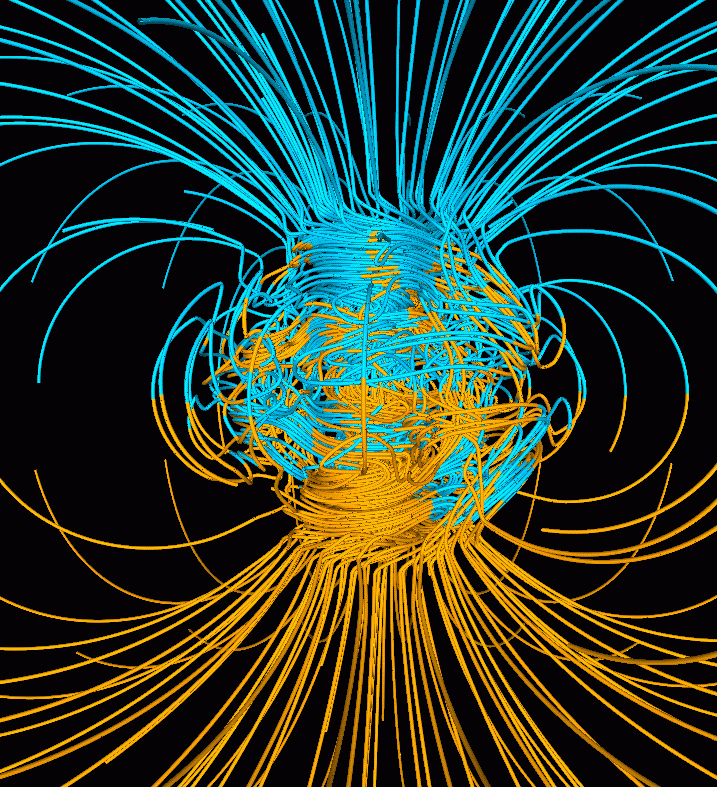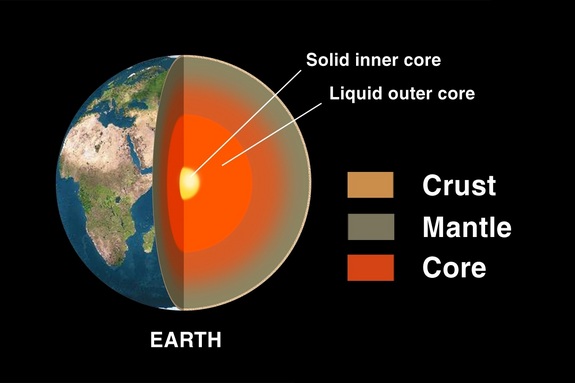
Earth's 6-Year Twitch Changes Day Length

Periodic wobbles in Earth's core change the length of a day every 5.9 years, according to a study published today (July 10) in the journal Nature.
Teasing out this subtle cycle, which subtracts and adds mere milliseconds to each day, also revealed a match between abrupt changes in the length of day and Earth's magnetic field. During these short-lived lurches in the magnetic field intensity, events called geomagnetic jerks, Earth's day also shifts by 0.1 millisecond, the researchers report. Since 1969, scientists have detected 10 geomagnetic jerks lasting less than a year.
Seemingly negligible, these fleeting variations are mighty to those who study the planet and its core. All of a sudden, a planet changes its spin like a figure skater open or closing her arms. The rotational effect helps scientists understand what's happening inside the Earth's core. Shifts in the magnetic field also provide clues to the inaccessible iron core. But their source remains a mystery.
Lead study author Richard Holme suspects a shimmy in the solid inner core that drives the 5.9-year cycle, transferring angular momentum to the outer core. But no one knows what causes geomagnetic jerks.
"I have no clue," said Holme, lead study author and a geophysicist at the University of Liverpool in the U.K. "Something is happening at the core-mantle boundary, because you're seeing the geomagnetic and the rotational effect at the same time, but we don't know what's going on," Holme told LiveScience's OurAmazingPlanet.
What's up down there?
Researchers still actively debate how the fluid outer core produces our planet's protective magnetic field, which has weakened and flipped polarity many times in geologic history. [What if Earth's Magnetic Poles Flip?]
Sign up for the Live Science daily newsletter now
Get the world’s most fascinating discoveries delivered straight to your inbox.

Scientists believe that gyrating iron fluid generates Earth's magnetic field, like a giant dynamo. Both yearly and millennial-scale changes in the field have been attributed to the swirling, spinning outer core. Tracking changes in the magnetic field helps researchers create models of how the dynamo may work.
"Essentially, we are using the variations as a tracer for flow," said Mathieu Dumberry, a geophysicist at the University of Alberta in Canada, who was not involved in the study.
Since geomagnetic jerks were first discovered in 1969, researchers have sought to explain and model how Earth's dynamo produces these quick changes in the magnetic field.
Finding a connection with changes in the length of day provides a new way of thinking about the phenomenon, Holme said.
For example, the results could help modelers better understand how the core and mantle exchange angular momentum, Holme said. Perhaps electromagnetic friction creates torque, akin to an electric car battery. But the electrical conductivity of the lower mantle (or the ease with which electrical charges flow within it) can't be too high, or it would cause a delay in the magnetic field responding to the rotational shift, Holme said. Instead, Holme and co-author Olivier de Viron of the Institut de Physique du Globe in Paris saw simultaneous geomagnetic jerks and jumps in the length of day.
"We've got some ideas, but it's just me having an amused flight of fancy. I'm a data hound, and I want to propel thinking about this," Holme said.
But Dumberry is not convinced that the study proves a link between jerks and changes in day length. "In that, it's not such a strong story," he said. There is a remarkable correlation between a geomagnetic jerk in 2003 and a length of day change, but earlier links aren't as strong, he said.
Length of day oscillates
Other forces also change the planet's spin. Since Earth formed, tugging from the sun and moon have slowed the planet's rotation. On shorter time scales, earthquakes, melting glaciers, ocean currents and strong winds, such as the jet stream, can alter how fast the planet spins, shortening or lengthening a day by about 1 millisecond.
Holme and de Viron removed these external and planetary effects from five decades of length of day data, exposing the 5.9-year period. They then compared bumps in the cycle, which correspond to sudden jumps in the length of day, with geomagnetic jerks detected since 1969.
Dumberry praised the pair's careful work in extracting the 5.9-year signal. "This multiyear length of day signal is the best so far," he said.
Email Becky Oskin or follow her @beckyoskin. Follow us @OAPlanet, Facebook & Google+. Original article on LiveScience's OurAmazingPlanet.

